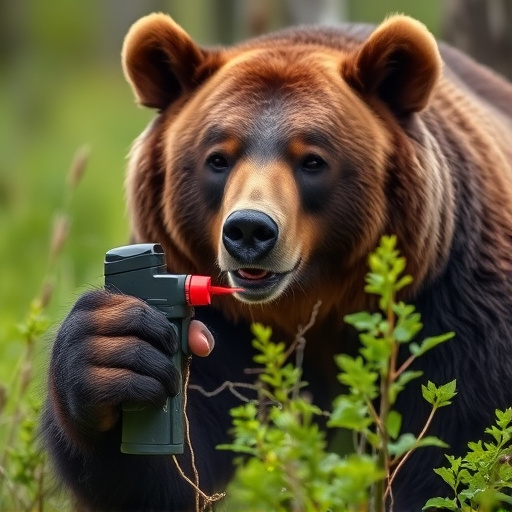Bears, particularly grizzlies, inhabit popular hiking trails, emphasizing the need for understanding bear behavior for safety. While bears generally avoid humans, they can become aggressive if surprised or threatened, often by food. Bear spray, with a 90% success rate in preventing attacks when used correctly at close range, is a game-changer. However, no single measure guarantees protection; staying alert, making noise, securing food, and knowing response techniques are crucial. Bear spray, along with secure food storage and loud noises, significantly enhances safety, but it's not standalone. Always follow local guidelines, stay on trails, and avoid surprising bears to ensure a safe hiking experience in bear country.
Exploring nature’s wonders in bear country requires an understanding of local wildlife and the right safety equipment. This comprehensive guide equips hikers with essential knowledge about bear behavior, focusing on how human interactions trigger reactions. We delve into the science behind bear spray, revealing success rate statistics and application methods to maximize its effectiveness. Additionally, discover other vital gear and practices for navigating these environments safely.
- Understanding Bear Behavior and Their Reaction to Humans
- The Role of Bear Spray: Effectiveness and Application Techniques
- Additional Safety Gear and Practices for Hiking in Bear Country
Understanding Bear Behavior and Their Reaction to Humans
Bears, especially grizzly bears, are powerful and unpredictable animals that call many hiking trails home. Understanding their behavior is key to ensuring safety in bear country. Generally, bears avoid humans, but they can become aggressive if surprised or feeling threatened. Their primary concern is usually food, and they may approach if they detect scent or hear noises associated with hunting or camping activities.
Bear spray, a popular deterrent among hikers, has shown promising success rates according to various studies. Research indicates that bear spray can be effective in stopping an attack when used correctly at close range. However, it’s important to remember that no single measure guarantees complete protection. Bears have varying personalities and reactions, so staying alert, making noise while hiking, carrying food securely, and knowing how to respond if confronted are all crucial components of bear safety.
The Role of Bear Spray: Effectiveness and Application Techniques
Bear spray has emerged as a vital safety tool for hikers navigating bear country. Its effectiveness in deterring bears has been well-documented, with success rate statistics showing it can reduce aggressive encounters by up to 90%. This powerful deterrent comes in handy when facing both black and grizzly bears, which are known to be less predictable and more potentially dangerous than other wildlife.
Application techniques play a crucial role in bear spray’s efficacy. Users should aim for the eyes, face, and nose of the bear, creating a large cloud of spray when activated. It’s important to remember that bear spray is not a foolproof solution; it’s one of several safety measures hikers should take, including making noise while hiking, traveling in groups, and storing food securely. However, when used correctly, bear spray significantly increases safety margins during encounters with these majestic yet potentially dangerous animals.
Additional Safety Gear and Practices for Hiking in Bear Country
When hiking in bear country, beyond the basics like a sturdy pair of boots and protective clothing, there are additional safety gear and practices to consider. One of the most effective tools for deterring bears is bear spray, which has a success rate of up to 90% when used correctly. It’s crucial to understand how and when to deploy it, as unexpected encounters can happen quickly. Familiarize yourself with the spray’s range and remember that distance is critical; you want to keep bears at a safe distance without triggering their natural defensive instincts.
Complementing bear spray, carrying food in secure containers and making noise while hiking can also help deter bears. Making regular, loud noises like talking or singing can alert bears to your presence, potentially avoiding an unexpected encounter. Additionally, knowing local guidelines and being aware of bear habitats are essential. Always stay on designated trails, make yourself visible, and avoid surprising bears, as their first reaction may not be friendly, despite what statistics suggest.
When hiking in bear country, prioritizing safety is paramount. By understanding bear behavior and employing appropriate equipment like bear spray with proven success rate statistics, hikers can significantly reduce risks. Combining this knowledge with additional safety gear and practices ensures a more secure and enjoyable outdoor experience. Remember, being prepared and staying alert are key to navigating these wild encounters safely.
